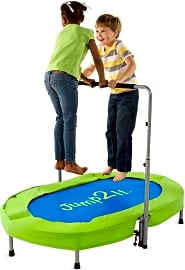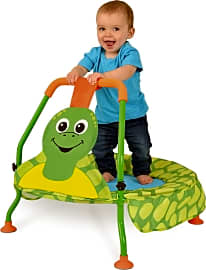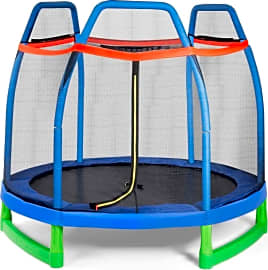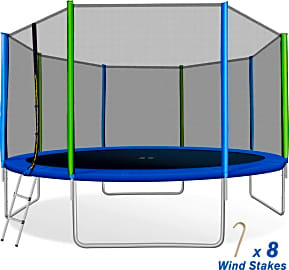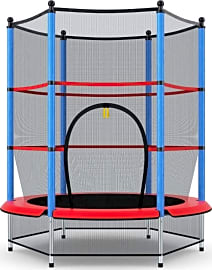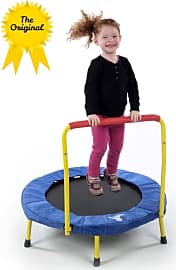The 10 Best Kid's Trampolines

This wiki has been updated 41 times since it was first published in May of 2016. Trampolines offer a great way for toddlers and children to expend their energy, and they help build strength and coordination, too. We've selected models that sit close to the ground and have features such as handlebars and enclosure nets to keep boys and girls safe. However, even if these selections are rated as suitable for little ones, adults should always supervise their use. When users buy our independently chosen editorial recommendations, we may earn commissions to help fund the Wiki.
Editor's Notes
September 22, 2020:
Before buying a trampoline for your kid, whether they be a toddler or a teenager, you need to be aware of the potential dangers they present. While we have made sure to only include models with safety features to help minimize the chances of injury, no amount of padding or netting can completely eliminate the possibility. With that in mind, you need to make sure that you always supervise your children when using one of these, and also follow the manufacturer's recommended guidelines for age and weight recommendations.
In creating our list of kid's trampolines, along with safety, durability was a top priority. We looked for materials that could withstand the abuse that even the rowdiest of children may put them through, and for features that could give parents peace of mind that their little ones wouldn't injure themselves. Furthermore, we included a range of sizes suitable for several developmental stages and some picks with a few extras that improve the fun factor.
In terms of longevity, we appreciate that the Giantex Seven-Foot and the Giantex Outdoor Indoor Mini both have steel frames, and that the SereneLife SLTRA10 has stable L-shaped legs along with a strong polypropylene mat. Each of these choices also has safety nets to prevent accidents. The Diggin' Foldaway Mini tends to rip where the mat connects to the frame, so we had to remove it.
If you want something you can take out for playtime but easily put away, you may like that the HearthSong Jump2It is very lightweight and portable. Another option is the Galt Nursery 1004471 because its handlebar and legs easily come off for storage. Unfortunately, the JumpSport iBounce 2 is supposed to be easy to take apart, but it actually proves quite difficult to disassemble, so we eliminated it during this update to make room for the Original Toy Company Fold & Go. The Kangaroo 36-Inch Indoor can tip over, posing a serious hazard, so we removed it.
There was nothing inherently wrong with the Little Tikes 3-Foot or the Pure Fun Kids Preschool Jumper, but we wanted to make room for a couple of more diverse options. We added in the Jump Power Rectangle Combo, which has a swing for an additional way to expel some jitters. The Little Tikes Climb 'N Slide, which has a ladder and slide, also earned a place because it provides kids with some extra exercise, and is a nice choice when you don't have room for a full slide.
July 27, 2019:
The American Academy of Pediatrics has famously warned against the use of trampolines by children due to the risk of injury they present. The AAP even reported that safety measures such as pads and netting don't seem to help much.
These kids' trampolines, however, might be safer. They sit very close to the ground, they generally have room for only one child at a time, and they do not have enough spring in them to launch a child higher than a few inches. They certainly aren't big enough to allow kids to attempt flips, which are a high cause of injury on full-size trampolines. Still, you'll want to supervise your child closely while they use these diminutive bouncers.
In this update, we removed a couple of items due to concerns about their availability. Added the Diggin' Foldaway Mini as a good option for toddlers who are working on their balance and stability. It will provide just enough spring to let them feel like they're jumping, but not so much that they can hurt themselves.
Special Honors
Wish 55-Inch Mini Kids Indoor Trampoline The frame of the Wish 55-Inch Mini Kids Indoor Trampoline is made of rust-resistant steel and supported by six legs for stability. Its enclosure net keeps youngsters safely inside and its highly-elastic mat gives an impressive bounce. The mesh goes all the way to the ground to prevent little ones from crawling beneath it, and its poles are covered in fun-colored foam padding. wish.com
Kerrogee 25-Inch Round Toddler Trampoline The Kerrogee 25-Inch Round Toddler Trampoline has a foam padded cover over its galvanized metal springs, so it will provide a good bounce while keeping your child safe from pinches. It has a wide handlebar that users can grab onto for stability and a weight capacity of 180 pounds. Plus, parents can take comfort in knowing this sits barely eight inches off the ground. wayfair.com
How To Choose The Right Trampoline
For children under the age of six, some smaller trampolines can be used indoors during the cold winter months.
If you've got a wriggly little jumping bean at home, you've probably considered getting a trampoline at least once. When you picture the typical trampoline, you may think you need to be blessed with a spacious backyard and a large disposable income to accommodate one of those giant contraptions, but trampolines actually come in a variety of sizes to fit any space and budget.
Regardless of the amount of space you may or may not have available, you'll also want to consider the primary purpose of your trampoline before choosing a style and size. Do you have a young gymnast in training, or are you searching for a way to get a couch potato moving? Will only small children play on it, or do you plan to use it to change up your workout occasionally?
For children under the age of six, some smaller trampolines can be used indoors during the cold winter months. This is ideal for an age group that seems to possess an endless supply of energy. Look for a model with rubberized feet designed to protect your floors. Another reason to go with a more compact trampoline is that they often come with a handlebar so that younger jumpers can keep their balance while developing better coordination.
For older, more experienced jumpers, a larger unit that allows them to jump higher makes sense. Only consider a model that comes with a safety net enclosure and covered springs. Having an outdoor trampoline for older children also gives them an extra incentive to spend some time outdoors at an age when they often begin spending too much time inside.
Trampoline Safety Tips
You would be hard-pressed to find a medical association that expressly approves the usage of trampolines, but many parents see them as an essential outlet for their high-energy, rambunctious youngsters. Because of this, you can find expert safety guidelines from organizations like the American Academy of Orthopedic Surgeons, to help keep your children safe on a trampoline.
Regardless of age, only one jumper at a time should occupy the trampoline; otherwise, the smaller participant is far more likely to become injured.
Adult supervision is probably the single most important safety measure. When you are considering your purchase of a trampoline, keep in mind that your child's trampoline time is not going to be your window for making dinner or getting chores done around the house. As you supervise this activity, consider it a smart investment in ensuring you have a properly tuckered out child at bedtime later that evening. Parents also need to enforce a strict “no somersault” rule. These high-risk tricks should only be attempted with the help of professional instructors.
Most experts agree that children under the age of six should not jump on the large, full-size trampolines. Regardless of age, only one jumper at a time should occupy the trampoline; otherwise, the smaller participant is far more likely to become injured. You should also never leave a ladder near an outdoor trampoline to protect small children or neighbors from climbing in and jumping unsupervised.
Proper installation and maintenance will also go a long way towards keeping your little jumpers safe. Trampolines should always sit on a solid, level surface. Caregivers should inspect equipment on a regular basis for worn or damaged parts. It's a good idea to invest in a quality trampoline that includes protective padding around all metal springs and hooks, or purchase shock-absorbing pads for any exposed parts. While you might spend a little more upfront, you'll save a bundle compared to a trip to the emergency room.
A Brief History Of The Trampoline
While the trampoline is a relatively modern invention, there are some historical trampoline-esque activities that serve as a percursor to its development. For hundreds of years, the Inuit people of Alaska have used a walrus skin, held taut by multiple people to toss blanket dancers in the air as part of their whale harvest celebrations. There is some evidence this action was also used as way to spot animals off at a distance when hunting.
Nissen and Griswold discovered their invention might have mass appeal when they moved the trampoline to a nearby YMCA camp.
The first trampoline as we know it today was built in 1934 by gymnastics competitors George Nissen and Larry Griswold to assist their team in training to do somersaults, back flips and other tricks. Both were students at the University of Iowa at the time. Their creation was inspired by the tight nets trapeze artists used during their circus performances. They constructed it in the basement of a local YMCA using angle iron, a canvas bed and rubber springs, painstakingly threading the nets by hand.
Nissen and Griswold discovered their invention might have mass appeal when they moved the trampoline to a nearby YMCA camp. The young campers loved bouncing on it and often begged them to play on it. In 1942, they formed a company and began manufacturing trampolines for recreational and home usage. By the late 1950s, trampolining became so popular that recreational jump centers sprung up around the country, often at odd places like gas stations. These places lacked proper padding and safety measures, so they soon fell out of favor.
The trampoline has been used in some unconventional ways to train pilots and astronauts. It was used to train fighter pilots as early as World War II. It was discovered that trampolines could be used to help pilots reorient themselves after revolving in space and desensitize them to rapid twists and turns they would experience in battle. It also serves as a superior form of cardio conditioning over the basic treadmill. Early astronauts also benefited from this kind of training, as they were able to momentarily simulate the feeling of weightlessness.
The sport of competitive trampolining began in American universities in the 1950s, but enthusiasm for the sport quickly spread throughout the world. The first world championship was held in London in 1973. By the year 2000, the sport had enough widespread popularity to make its debut at the Sydney Olympic Games, with both women's and men's events.


